Erythrophysa transvaalensis
Erythrophysa transvaalensis I.Verd.
Family: Sapindaceae
Common names: Transvaal red balloon (Eng.); Transvaalse rooiklapperbos (Afr.)
SA Tree No: 436.2
Introduction
Erythrophysa transvaalensis is an exciting deciduous shrub or small tree, suitable for small gardens in frost-free areas.
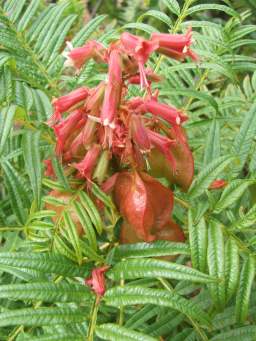
Description
Description
Erythrophysa transvaalensis grows up to 4 or 5 m in height with slender stems branching from ground level or just above the base. The bark is brown, smooth and shiny. The stems are slender and brittle.
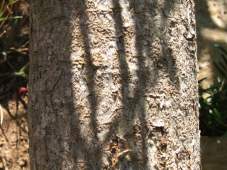
The graceful leaves are compound, with about 7 pairs of leaflets and a terminal one. They are dark grey-green and crowded at the ends of the branches.
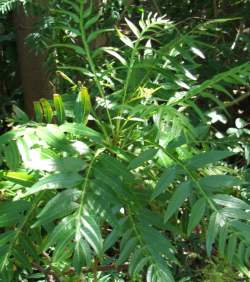
The attractive flowers are produced in erect panicles before or with the new leaves. They are green, suffused with red. The flowers have four clawed petals and straight, protruding stamens. The fruit is a large, balloon-like structure, three-angled, with three chambers; each chamber contains 1 or 2 large, round, smooth black seeds.
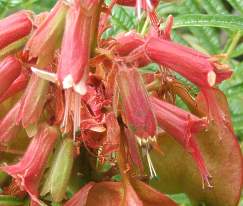
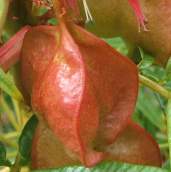
Conservation Status
Status
Erythrophysa transvaalensis is listed as a protected tree by the Nature Conservation legislation of South Africa, but it is not listed on the red data list of threatened plants.
Distribution and habitat
Distribution description
This species has a limited distribution in South Africa occurring in Gauteng, Limpopo and the North West Province. It grows in a few places in western Gauteng, on the slope of a hill near the Bospoort Dam in the Rustenburg District, near Thabazimbi, and in the western Waterberg. It was first thought to be endemic to syenite hills (koppies ) in the Pilanesburg Nature Reserve, but it has been found since in a wider area (Balkwill 1994). I.C. Verdoorn (1942) described one of the original collections as coming from a norite koppie (near Bosport Dam). It also occurs in Limpopo in a few areas including near the Strydom tunnel on dolomite (Pieter Winter pers. comm.). It has also been collected in Zimbabwe.
Derivation of name and historical aspects
History
The genus name Erythrophysa is derived from the Greek word erythros, red, and physa meaning bag, and refers to the red, balloon-like fruits. The specific epithet transvaalensis is from the locality name Transvaal. Mr V.K Hands who was the engineer in charge of building Bospoort Dam, sent the first species to the Botanical Research Institute in 1933.
Ecology
Ecology
Balkwill (1994) reported that more research needed to be done to establish what effects fire or soil minerals might have on the distribution of this tree. It is reported to have tuberous roots (Ernst van Jaarsveld pers. comm.). These might have a bearing on its ability to survive fire. It is also reported to occurs amongst boulders which might also protect it from veld fires.
Uses
Use
The seeds are reported to be used by African women to make beads. Although this tree has great potential as a garden plant, it is not widely grown at present.
Growing Erythrophysa transvaalensis
Grow
Erythrophysa transvaalensis could do well in a big pot and close to a swimming pool. It is easily grown from seed which usually germinate well. Sow the seed immediately on a well-drained soil mix in a seed tray. Cover the seed with a thin layer of fine bark or river sand. Water with a fine nozzle and place the seed tray in a warm position. The seed will take four to six weeks to germinate.
This tree can also be grown from cuttings if seeds prove problematic.
References
- Balkwill, K. 1994. Further notes on Erythrophysa transvaalensis. Trees in South Africa 45: 41.
- Coates Palgrave, K. 1977. Trees of southern Africa,edn 1. Struik, Cape Town.
- Palmer, E. & Pitman, N. 1972. Trees of southern Africa, vol. 2. Balkema, Cape Town.
- Van Wyk, A.E. (Braam) & Van Wyk, P. 1997. Field guide to trees of southern Africa. Struik, Cape Town.
- Verdoorn, I.C. 1942. Erythrophysa transvaalensis. Flowering Plants of Africa 22: t. 857.
Credits
Giles Mbambezeli
Kirstenbosch National Botanical Garden
April 2006
With additions by Yvonne Reynolds
Plant Attributes:
Plant Type: Shrub, Tree
SA Distribution: Gauteng, Limpopo, North West
Soil type: Sandy, Loam, Metal-rich
Flowering season: Early Summer
PH: Neutral
Flower colour: Red, Pink
Aspect: Full Sun
Gardening skill: Average
Special Features:
Horticultural zones










Rate this article
Article well written and informative
Rate this plant
Is this an interesting plant?
User Comments
Helena VonDrakenstein, Canada
July 14, 2018 at 3:35 AMI am growing these from seed...gotten from Silverhill seeds in Gauteng. Very sadly Rod and Rachel Saunders the owners were murdered recently in 2018 by some crazy people while they were out gathering seeds. Very sad. The company was a valuable and unique source of African seeds that no one else was selling. I don't know how much longer Silverhill Seeds will operate..but it will close.I germinate these seeds by carefully scarifying the seed coat (not too deep) with an electric Dremel tool and then drop into water for 24 hours.They then go on to moist paper towel in a covered plastic box and will begin to germinate in about 10 days . As soon as I see the radicle pushing out they get planted and covered by about 1/2 inch of soil
Login to add your Comment
Back to topNot registered yet? Click here to register.